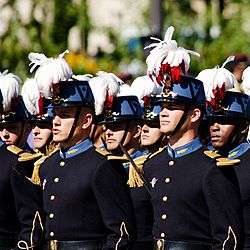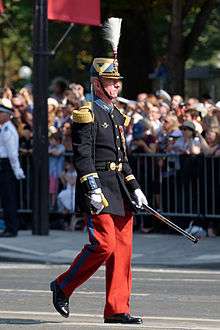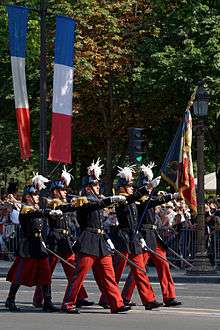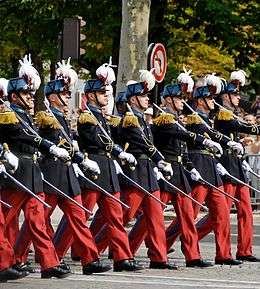École spéciale militaire de Saint-Cyr
 | |
| Motto | "Ils s'instruisent pour vaincre": literally "They study to vanquish" or "Training for victory". |
|---|---|
| Type | Military college |
| Established | 1 May 1802 |
| Commandant | Major General Éric Bonnemaison[1][2] |
| Undergraduates | none (undergraduate degree in a military or civilian preparatory college is a prerequisite) |
| Postgraduates | equivalent of a master's degree |
| Location | Coëtquidan in Guer, Morbihan, Brittany, France |
| Campus | rural |
| Colours | Red, white and blue |
| Nickname | Saint-cyrien, cyrard |
| Website | www.st-cyr.terre.defense.gouv.fr/ |
The École Spéciale Militaire de Saint-Cyr (ESM, literally the "Special Military School of Saint-Cyr") is the foremost French military academy. It is often referred to as Saint-Cyr (French pronunciation: [sɛ̃ siʁ]). Its motto is "Ils s'instruisent pour vaincre": literally "They study to vanquish" or "Training for victory". French cadet officers are called "saint-cyriens", or "cyrards". The École Spéciale Militaire de Saint-Cyr is located in Coëtquidan in Guer, Morbihan department, Brittany, France.[1][3]
French students who enter the École Spéciale Militaire de Saint-Cyr as cadets are about 21 years old, and undergo three years of training. All ESM cadets graduate with a master of arts or a master of science and are commissioned officers.[1][3]
The academy was founded in Fontainebleau in 1802 by Napoléon Bonaparte near Paris in the buildings of the Maison Royale de Saint-Louis, a school founded in 1685 by Louis XIV for impoverished daughters of noblemen who had died for France. The cadets moved several times more, eventually settling in Saint-Cyr, west of Paris, in 1808.
History



The École Spéciale Militaire was created by order of Napoleon Bonaparte on May 1, 1802 (the Law of 11 Floréal an X according to the then-official revolutionary calendar), to replace the École Royale Militaire then located in Fontainebleau. Renamed the École Spéciale Impériale Militaire after Bonaparte was proclaimed emperor, it moved in 1808 to Saint-Cyr-l'École (Yvelines) in the castle of the former Maison royale de Saint-Louis, a school for girls of the French nobility disbanded at the time of the Revolution.
The school trained a large number of young officers who served during the Napoleonic Wars. It remained stationed in Saint-Cyr-l'École after Napoleon's deposition and through all regime changes until 1940. After the defeat of the French Army against Germany in 1940, the school moved to the free zone, in the south of France, in Aix-en-Provence. After the invasion of the free zone by the Germans in 1942, the school was disbanded, but French cadet officer training went on, part in Cherchell (Algeria, then Free French territory) and part in the United Kingdom (Cadets de la France Libre) under General de Gaulle's command.
At the Libération of France in 1944, the school was reunited under the command of General de Lattre de Tassigny and settled in the military camp of Coëtquidan, Morbihan, because the "vieux bahut" (old school) had been severely damaged by an Allied bombing during the Libération campaign.
The École Spéciale Militaire de Saint-Cyr has remained there to this day. A reform in 1961 split the school into two entities: the current École Spéciale Militaire de Saint-Cyr (ESM), devoted to the training of direct-recruitment officers, recruited through an annual national competitive exam, and the École Militaire Interarmes (EMIA), cadets from internal recruitment (selected from non-commissioned officer (NCO) ranks and reserve officer ranks) and added a third entity, the École Militaire du Corps Technique et Administratif (EMCTA), devoted to the formation of administrative specialist officers. The school admitted its first female cadets in 1983 and underwent a minor reform in 2002 devised to broaden the diversity of its recruitment.
Since 1802, 65,000 Saint-Cyriens have been trained, along with 2,000 international cadets. Of the French graduates 9,639 died on the field of battle. Alumni also count 11 Maréchaux de France, three French heads of state, two flying aces, six members of the Académie Française, and one Blessed of the Catholic Church.
The school has links with both West Point and the Sandhurst Military Academy, including student exchanges.
Motto
Napoleon's original motto, "Ils s'instruisent pour vaincre" ("They study to overcome/conquer/win"), was changed by the restoration king, Louis XVIII, to: "Ils s'instruisent pour la Défense de la Patrie" ("They study for the Defence of the Fatherland"). The Napoleonic version was used again from 1848 to 1870. That motto was next changed to "Honneur et Patrie" ("Honour and Fatherland") until 1918, when it reverted again to the original Napoleonic wording.
Museum
The museum is open to the public Tuesday, Wednesday, Thursday and Friday mornings from 10 a.m. – 12 a.m. to group tours and afternoons to the public on Tuesday, Wednesday and Friday from 2:30 p.m. – 5 p.m. On the weekend, the museum is open to the public from 10 a.m. – 12 a.m. and from 2 p.m. – 6 p.m. The museum is closed to the public on Mondays and it is closed from 2:30 p.m. to 5 p.m. on Thursdays. The museum is located on Rivoli court. The permanent collection explores the lives of the Saint-Cyrien from the end of the ancient regime to today. The collection shows the evolution of the uniform, personal objects, artwork, authentic documents, arms, clothing and family relics.
Traditions
Class names and insignia
Since 1829, every class (promotion) of Saint-Cyr chooses a name. It can be a nickname (du Firmament, "of the Stars", for the first one), the name of a famous battle (Sevastopol for the 1855–56 Class), the name of a famous soldier or general (Bayard, 1923–25 Class, Foch, 1928–30 Class). Since 1934, every class also chooses a special insignia.
Uniform
Cadets of Saint-Cyr wear in full dress (grande tenue) a special uniform, derived from the 1845 Regulations Infantry Officer Dress. This dress incorporates a dark-blue tunic, red trousers and a shako with red and white plumes. Facings are light blue, as is the képi worn on less formal occasions. Red fringed epaulettes are worn by cadets and yellow by cadet-officers. This traditional uniform was worn by both cadets and instructors at Saint-Cyr from 1845 until 1914 and then again from 1930 until 1939.[4] After World War II it was again adopted in 1949.[5]
The shako plumes are nicknamed Casoars (cassowaries), because they were first adopted in 1855 at the time of this colorful bird's first appearance in the Paris Zoo. While the plumes were not at first welcomed by the cadets, they have become a symbol of Saint-Cyr. The Saint-Cyr cadets of the class of 1913–14, graduating ahead of time with the outbreak of World War I, reportedly vowed to lead their platoons in battle wearing the casoar on their service kepis.[6]
Ceremonies
The various steps of the cadets' formation are celebrated in various ceremonies, all performed during nighttime. At the beginning of the first year, after boot camp, the cadets are welcomed with shakos granted to them by the third-year cadets. This is called the petit soir or "small night". At the end of the first year, the cadets are presented with the Casoar (the red and white plumes on their shakos) and with their officer's sword. This is the grand soir or "big night". At the end of the second year, cadets are officially commissioned second lieutenants. This is celebrated in the "baptism" (baptême) of the class, a ceremony in with every cadet receive the accolade from a senior officer. At the end of the third and final year, the cadets are promoted to the rank of lieutenant and receive their new insignia in a ceremony called the "triumph" (triomphe). This ceremony is also the time of solemn proclamation of the class name.
Re-enactment
Using authentic battle gear and uniforms of the period, re-enactments of famous battles and ceremonies are regularly staged. The most famous of these is the Battle of Austerlitz, which took place on December 2, 1805 and has been celebrated since. The December, 2, nicknamed "2S" by the Saint-Cyr cadets, is the date of many Saint-Cyr related celebrations in the military or among the associations of alumni.
Application
Cadets are recruited through a national annual competitive exam, after previous tertiary education. French students take exams on general knowledge, aptitude and intelligence; sit for an interview and pass a test of physical ability.
- Standard test (concours sur épreuves) : These saint-cyriens after undergraduate education, like most other French Grandes écoles, two years of classes préparatoires aux grandes écoles or a three-years bachelor's degree in a university.
- Interview and record exam (concours sur titres) : These saint-cyriens are recruited after graduate education (master's degree). They will follow only the last year of Saint-Cyr training.
In addition, a number of foreign students are admitted annually.
Training
The course is three years long and covers academic training, military training, physical training and leadership training.
The first-year involves military training and academics. The last two years focus on academics with one to three week breaks for military training. Officer cadets at St-Cyr are commissioned officers. The cadets attend school from September to July.
Each promotion (class) of the ESM is organised as a battalion. The 1st-year students (rank of élève-officier – Cadet) are France's Third Battalion, 2nd-year (rank of aspirant – Officer Designate) are France's Second Battalion and third-year (rank of sous-lieutenant – 2nd Lieutenant) are France's First Battalion. The Reserve Officers, Special Duty Officers and Aspirants trained at the ESM in short sessions are France's Fourth Battalion.
Upon graduation, cadets are awarded the diploma of Saint-Cyr, which is a master's degree in Strategy and Internationals Relations or Management, or an engineer's degree, depending on their major. Majors are in engineering or science subjects or specialization in classics, modern or ancient history, modern languages, applied modern languages, geography, science and economics, law, computer science, physical education, political science or Asian studies.
Graduates leave the school with the rank of lieutenant and join the specialist school of the branch they select for one additional year, before being assigned to a regiment to serve as a platoon leader.
Distinguished alumni
- Zine El Abidine Ben Ali: former President of Tunisia
- Abdullah Atfeh, former Chief of Staff and Minister of Defense of Syria
- Ion Antonescu (1882–1946): Chief of the Romanian Government during WW II
- Michel Arnaud (1915–1990): 1935
- Bahram Aryana (1906–1985): Military Chief of Staff, Iran
- Felipe Ángeles, Mexican revolutionary, (1868–1919)
- Iosif Butoi (1900–1957): Military Chief of the Romanian Military Academy
- François Certain Canrobert (1809–1895): 1828
- Achille Pierre Deffontaines youngest French general to die in World War I
- Charles de Gaulle (1890–1970): 1912
- Henri Hay De Slade, flying ace, WWI (1893–1979)
- Louis Franchet d'Espérey (1856–1942): 1876
- Philippe Leclerc de Hautecloque (1902–1947): 1924
- Hélie de Saint Marc (1922–2013)
- Gabriel Brunet de Sairigné (1913–1948): 1933
- Ettore Perrone di San Martino (1789–1849): 1806
- David Galula (1919–1967): 1940
- Babacar Gaye : Head of MONUSCO
- Adolphe Guillaumat (1863–1940): 1884
- Jean de Lattre de Tassigny (1889–1952)
- Charles de Foucauld (1858–1916): 1876
- Joseph Gallieni (1849–1916)
- Carlos Guerrero: War Minister of Ecuador (1926)
- Jacques Guillermaz (1911–1998) 1937 Diplomat, Sinologist
- Sardar Homayoun (1850s–1930s)
- Alphonse Juin (1888–1967): 1912
- Arthur Constantin Krebs (1878–1964)
- Auguste Lahoulle, flying ace, WWI (1891–1959)
- François-Henry Laperrine (1860–1920)
- Guillaume Konsbruck (1909–1983): 1931–1933, Luxembourgian politician
- Paul Legentilhomme (1884–1975): 1907
- Liao Yaoxiang (1903–1968): 1936, Chinese general in the Second Sino-Japanese War
- Louis II, Prince of Monaco, (1870–1949)
- Hubert Lyautey (1854–1934)
- Patrice MacMahon (1808–1893): 1827
- Dragoljub Mihailović
- Abdollah Khan Momtaz (1909–1912), Iranian diplomat
- Pierre Nord, writer (1900–1985)
- Hüseyin Nâzım Paşa (1848–1913): Chief of Staff of the military of the Ottoman Empire
- Philippe Pétain (1856–1951)
- Aimable Jean Jacques Pélissier (1794–1864)
- Peter I of Serbia (1844–1921): 1862
- Lucien Poirier (1918–2013): 1939
- Haj Ali Razmara (1901–1951): Prime Minister of Iran 1950–51
- Joaan bin Hamad bin Khalifa Al Thani: son of the Emir of Qatar
- Jean-Etienne Valluy (1899–1970)
- Maxime Weygand (1867–1965): 1897
References
- 1 2 3 "Modern Languages — Norwich University College of Liberal Arts". Retrieved 30 January 2015.
- ↑ "Biographie du général Éric Bonnemaison" (PDF). st-cyr.terre.defense.gouv.fr (in French). Archived from the original (PDF) on 27 June 2011.
- 1 2 "Les écoles de Saint-Cyr Coëtquidan / Site Saint Cyr Coëtquidan – Les écoles de Saint-Cyr Coëtquidan". Retrieved 30 January 2015.
- ↑ Jean-Pierre Baly, page 17 "La Gazette des Uniformes", no 193, Juillet-Aout 2001
- ↑ Jean-Pierre Baly, page 9 "La Gazette des Uniformes", no 154, Mai-Juin 1995
- ↑ Christian Benoit "Les saint-cyriens entrant en guerre", pages 44–49 "Armes Militaria" no 259 Fevrier 2007
External links
| Wikimedia Commons has media related to École spéciale militaire de Saint-Cyr. |
- Official website (in French)
- Presentation on St-Cyr in English, on the website of Norwich University, Vermont (Information on Norwich's study-abroad program at St-Cyr)
- Presentation on the website of the French Ministry of Defence (in French)
- "La Saint-Cyrienne": Association of cadets and former cadets of St-Cyr (in French)
Coordinates: 47°56′43″N 2°09′08″W / 47.9453°N 2.1522°W